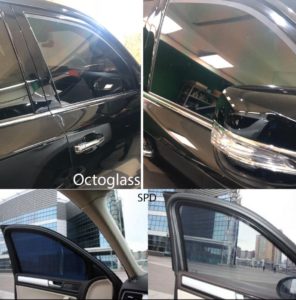Another technology that is widely available on the market and allows you to change the light transmission is SPD. This technology has been developing for several decades and is a nano-blinds that open slightly under the influence of an electromagnetic field from an alternating current, thereby increasing light transmission. The reverse process occurs under the influence of thermal Brownian motion. SPD technology can change the color of glass from dark blue to relatively transparent with a neutral coloration. The main disadvantage of this technology can be considered that in the most transparent state, the light transmission does not exceed 60%. Based on this fact, we can conclude that the use of such technology cannot be applied where there are requirements for minimum light transmission, for example, on vehicles. Another disadvantage of SPD, which is key for many consumers, is a high haze coefficient of glass, regardless of its state of light transmission.
Smart glass technology developed by Octoglass has a light transmittance of over 70%, and if desired, can be reduced to zero light transmittance in a dimmed state. In contrast to SPD technology, electrochromic glass does not have additional haze and remains at the 4-6% boundary like ordinary glass.


